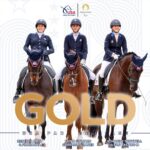 “Get on your horse, point it to the west, and when people start speaking French, it means you have gone too far.” Technically correct, that perhaps tongue-in-cheek advice was given to Tim Cope by a friend in Melbourne, where the Australian adventurer spent a year preparing for the journey of a lifetime – to ride approximately 6,000 miles by horseback from Mongolia to Hungary, to understand the nomadic ways of horsemen that have followed the route since the days of Genghis Khan (1162?-1227). Fluent in Russian and trained as a wilderness guide, Cope had survival skills, but his experience at riding and caring for horses was virtually nil. With the audacity found only in the very young or foolish, Cope started his journey in 2004 at the age of 25. Three and a half years and a series of thirteen “hero’s horses” later, he reached the shores of the Danube River. Cope was long fascinated by
“Get on your horse, point it to the west, and when people start speaking French, it means you have gone too far.” Technically correct, that perhaps tongue-in-cheek advice was given to Tim Cope by a friend in Melbourne, where the Australian adventurer spent a year preparing for the journey of a lifetime – to ride approximately 6,000 miles by horseback from Mongolia to Hungary, to understand the nomadic ways of horsemen that have followed the route since the days of Genghis Khan (1162?-1227). Fluent in Russian and trained as a wilderness guide, Cope had survival skills, but his experience at riding and caring for horses was virtually nil. With the audacity found only in the very young or foolish, Cope started his journey in 2004 at the age of 25. Three and a half years and a series of thirteen “hero’s horses” later, he reached the shores of the Danube River. Cope was long fascinated by
Genghis Khan and the Mongol nomads, whose territory eventually
became the largest land empire in history. Stretching from Korea in
the east to Hungary in the west, the sub-Arctic in the north to Indonesia in the south, it was all made possible by one factor – the horse. Cope’s award-winning memoir about his often harrowing experience, titled On the Trail of Genghis Khan: An Epic Journey Through the Land of the Nomads, is replete with nomadic history that reveals Cope’s gifts as a scholar as well as an intrepid traveler.
In a recent telephone conversation with Tim Cope, who was in
Washington, D.C. as part of his whirlwind book tour, I had an
opportunity to learn more about his expedition, as well as his recent
experiences at the Banff Mountain Film and Book Festival, where his
story took Grand Prize.
“There’s a very clear differentiation between ‘adventurers’ and what
I’m interested in,” said Tim. “For me, it’s not about the personal challenge, it’s about using adventure as a tool to experience cultural landscapes. The challenges were worth going through, but I wasn’t seeking the difficulties. You get guys at Banff who don’t speak about the beauty of the land they’re passing through.
They have their cell phones and all their digital equipment to keep them
occupied, so people have different goals.” Although he had to leave his
horses behind when he finished his journey and returned to Australia,
the bonds that Tim formed with his animals still inform his approach to
horses today. “I don’t have the lifestyle to have horses in Australia,” said Cope. “To get on a horse and live with them twenty-four hours a day is not the same as to jump on someone else’s horse and go for a trail ride. I’d prefer to stay on my feet than ride another person’s horse. I’d almost feel like I was cheating on my horse.” Considering he started as a novice rider and packer, Cope learned fast, especially when it came to protecting his horses from thieves, and finding them a steady supply of food and water. Cope continued, “Tim Severin, who wrote In Search of
Genghis Khan [about his own horseback ride with Mongolian nomads]
said to me: ‘Traveling across the Eurasian steppe is harder now than
it was two centuries ago, because there are fewer nomads who know
how to deal with horses,’ and he was right.” When asked about any revelations since publishing his book, Cope replied, “It can be a bit frustrating that people often ask, ‘Who did you do that for?’ meaning ‘What charity?’ People are generally ignorant about these peoples of the steppe, who live in this enormous landscape Tim Cope, the Australian adventurer, filmmaker, and author who rode 6,000 miles by horseback
from Mongolia to Hungary Because he was usually traveling alone, Tim Cope took most of the photographs of himself with a camera and timer mounted on a tripod. Here he and his horse Rusty pose at Blue Lake, located near a 9,840-foot pass in Mongolia.
Tigon, the tazi (sighthound) dog that was given to Tim Cope as a puppy by a Kazakh guide. His name means “fast wind” or “hawk,” and although Tim was reluctant to accept the gift, Tigon became an invaluable companion that made the trek from Kazakhstan to the Danube, and eventually all the way to Tim’s home in Australia. The cover of Tim Cope’s book, which recently won first prize in its category of Adventure Travel, and then went on to win Grand Prize at the 38th
Annual Banff Mountain Film and Book Festival and that have been through so much in the twentieth century. I think it’s because so many celebrities have their ‘causes’ that a journey such as mine is seen as an extravagance that has to be justified. But it’s important
that we have these journeys in our lives. Writing a book, too, is a
journey in itself. You’re continuing the journey in a way, yet going into waters you don’t even know.”
Reprinted from The Montecito Journal – Interview by Lynn P Kirst



